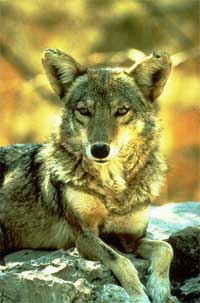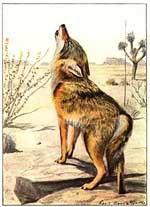|

 The coyote stands less than 0.6 m (2 ft) tall and varies in color from white-gray to tan with sometimes a reddish tint to its coat. A coyote's ears and nose appear long and pointed, especially in relation to the size of its head. It weighs between 9 - 22 kilograms (20 - 50 lb), averaging 14 kg (31 lb). The coyote can be identified by its thick bushy tail, which it often holds low to the ground. It can be distinguished from its much larger relative, the Gray Wolf, by its overall slight appearance compared to the massive 34 to 57 kg (75 to 125 lb) stockiness of the bigger canid. The coyote is an extremely lean animal and may appear underfed even if healthy. The coyote stands less than 0.6 m (2 ft) tall and varies in color from white-gray to tan with sometimes a reddish tint to its coat. A coyote's ears and nose appear long and pointed, especially in relation to the size of its head. It weighs between 9 - 22 kilograms (20 - 50 lb), averaging 14 kg (31 lb). The coyote can be identified by its thick bushy tail, which it often holds low to the ground. It can be distinguished from its much larger relative, the Gray Wolf, by its overall slight appearance compared to the massive 34 to 57 kg (75 to 125 lb) stockiness of the bigger canid. The coyote is an extremely lean animal and may appear underfed even if healthy.
Hybrids: The Northeast coyote and the Cape Cod coyote are thought to be a 50% mix with the Red wolf. Coyotes can also hybridize and produce fertile offspring with Gray wolves and domestic dogs. However practical constraints such as the timing of estrus cycles and the need for both parents to care for the pups limit such crosses in the wild. Hybrids between coyotes and Domestic dogs are known as "Coydogs"

Activity time: Coyotes are essentially nocturnal, but they will occasionally hunt during the day unless threatened by predators or humans.
 Diet: They are highly adaptable and live in a variety of different niches. Their behavior can vary widely depending on where they live, but in general they live and hunt singly or in monogamous pairs in search of small mammals including rabbits, mice, shrews, moles, and foxes. The coyote is an omnivore and adapts its diet to the available food sources including fruits, grasses, and vegetables along with small mammals. In Yellowstone National Park, before the reintroduction of the wolf, coyotes began to fill the wolf's ecological niche, and hunted in packs to bring down large prey. Diet: They are highly adaptable and live in a variety of different niches. Their behavior can vary widely depending on where they live, but in general they live and hunt singly or in monogamous pairs in search of small mammals including rabbits, mice, shrews, moles, and foxes. The coyote is an omnivore and adapts its diet to the available food sources including fruits, grasses, and vegetables along with small mammals. In Yellowstone National Park, before the reintroduction of the wolf, coyotes began to fill the wolf's ecological niche, and hunted in packs to bring down large prey.
 Mating: Coyotes mate for life. They breed around the month of February and four to six pups are born in late April or early May. Both parents (and sometimes undispersed young from the previous year) help to feed the pups. At three weeks old the pups leave the den under close watch of their parents. Once the pups are eight to twelve weeks old they are taught to hunt. Families stay together through the summer but the young break apart to find their own territories by fall. They usually relocate within ten miles. The young are sexually mature at 1 year of age. Mating: Coyotes mate for life. They breed around the month of February and four to six pups are born in late April or early May. Both parents (and sometimes undispersed young from the previous year) help to feed the pups. At three weeks old the pups leave the den under close watch of their parents. Once the pups are eight to twelve weeks old they are taught to hunt. Families stay together through the summer but the young break apart to find their own territories by fall. They usually relocate within ten miles. The young are sexually mature at 1 year of age.
 Howls: Hearing a coyote is much more common than seeing one. The calls a coyote makes are high-pitched and variously described as howls, yips, yelps and barks. These calls may be a long rising and falling note (a howl) or a series of short notes (yips). These calls are most often heard at dusk or night, less often during the day. Although these calls are made throughout the year, they are most common during the spring mating season and in the fall when the pups leave their families to establish new territories. Many people find these calls eerie or disturbing. As well, its howl can be very deceiving: due to the way the sound carries, it can seem as though it is in one place, when the coyote is really elsewhere. Howls: Hearing a coyote is much more common than seeing one. The calls a coyote makes are high-pitched and variously described as howls, yips, yelps and barks. These calls may be a long rising and falling note (a howl) or a series of short notes (yips). These calls are most often heard at dusk or night, less often during the day. Although these calls are made throughout the year, they are most common during the spring mating season and in the fall when the pups leave their families to establish new territories. Many people find these calls eerie or disturbing. As well, its howl can be very deceiving: due to the way the sound carries, it can seem as though it is in one place, when the coyote is really elsewhere.
Human calls: In rural areas, coyotes will respond to human calls. This is most often after the coyotes have started a howling session. They will also respond to recorded howls. In some of these areas, the coyotes will stop and wait for the humans to stop before resuming their howling session, once they've figured out that it isn't one of them that's been calling to them. In areas where the coyotes have grown accustomed to humans calling back to them, they tend to continue with simpler calls back to the humans and return to more complex calls when the humans get tired of calling to them. Playing a recorded wolf howl will make them stop for up to an hour before they start in again (probably because wolves prey upon coyotes).
Adaption to humans: Coyotes also thrive in suburban settings and even some urban ones. A study by scientists at Ohio State University yielded some surprising findings in this regard. Researchers studied Coyote populations in Chicago over a six-year period, proposing that coyotes have adapted well to living in densely populated urban environments while avoiding contact with humans. They found, among other things, that urban coyotes tend to live longer than their rural counterparts, kill rodents and pets, and live anywhere from parks to industrial areas. The scientists estimate that there are up to 2,000 coyotes living in Chicagoland and that this circumstance may well apply to many other urban landscapes in North America. In Washington DC's Rock Creek Park, coyotes den and raise their young, and scavenge roadkill and rodents. "I don't see it as a bad thing for a park,", the assigned National Park Service biologist told a reporter for Smithsonian Magazine (March 2006). "I see it as good for keeping animal populations in control, like the squirrels and the mice." As a testament to the coyote's habitat adaptability, a wily coyote was even captured in Manhattan's Central Park the same month, March 2006.

Many myths from Native American peoples that include a character whose name is translated into English as "Coyote". He can play the role of trickster or culture hero (or both), and also often appears in creation myths and just-so stories.
All text is available under the terms
of the GNU Free Documentation License
|